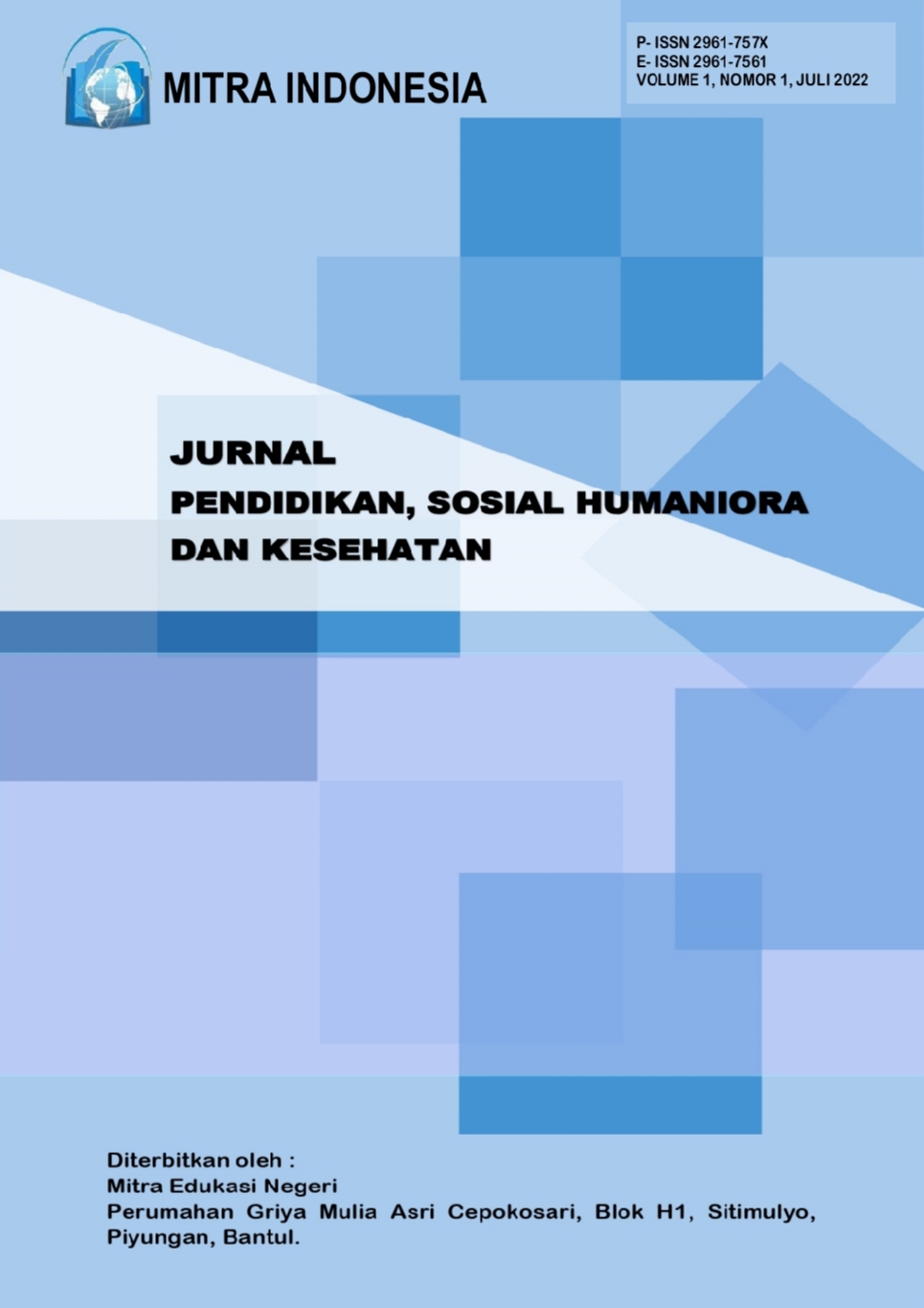Pengaruh Edukasi Prapersalinan Terhadap Kecemasan Ibu Hamil
Abstrak
Kecemasan secara fisiologis dan psikologis sangat menyita energi ibu hamil. Kurangnya pengetahuan tentang kehamilan dan perawatannya mendominasi penyebab kecemasan. Edukasi prapersalinan diharapkan dapat memperbaiki kondisi ibu hamil sebelum menjalani persalinan. Penelitian ini bertujuan untuk mengetahui pengaruh edukasi prapersalinan terhadap kecemasan ibu hamil enjelang persalinan. Metode. Penelitian kuantitatif kuasi eksperimental ini dilakukan dengan pendekatan pre dan post only test design. Penelitian ini dilaksanakan mulai Mei-Agustus 2020. Populasi penelitian ini adalah semua ibu hamil di Indonesia. Sampel berjumlah 53 orang yang diperoleh melalui metode purposive sampling. Kriteria inklusi responden adalah ibu hamil 29-36 minggu, bersedia aktif mengikuti program pendampingan secara klasikal dan pribadi selama empat minggu, dan memiliki akun aplikasi whatsapps. Alat ukur berupa kuesioner PRAQ (Pregnancy-Related Anxiety Questionairre-R2). Analisis bivariat dilakukan untuk melihat perbedaan sebelum dan sesudah perlakuan dengan menggunakan uji t berpasangan (paired t-test). Hasil penelitian. Sebagian besar subjek adalah ibu rumah tangga, hamil yang kedua, usia 20-25 tahun, dan pendidikan sarjana dan SMA, dan daerah asal subjek bervariasi dari 10 propinsi. sebagian besar ibu hamil mengalami kecemasan menjelang persalinan dalam kategori tinggi (39.6%). nilai sig. (2-tailed) sebesar 0.003<0.05, dan nilai t hitung lebih besar dari t tabel (3.146>2.011) yang menunjukkan bahwa edukasi prapersalinan berpengaruh terhadap penurunan kecemasan ibu menghadapi persalinan
Referensi
Rita Dewi Sunarno, Ni Luh Putu Ariastuti, N. M. (2013) ‘Hubungan Antara Tingkat Kecemasan dengan Lama Persalinan Kala I-Kala II pada Ibu Proimigravida di Rumah Bersalin Mardi Rahayu Semarang’, Journal of Chemical Information and Modeling, 53(9), pp. 1689–1699. doi: 10.1017/CBO9781107415324.004.
Ali, N. S. et al. (2012) ‘Frequency and associated factors for anxiety and depression in pregnant women: A hospital-based cross-sectional study’, The Scientific World Journal, 2012. doi: 10.1100/2012/653098.
Andersson, L. et al. (2004) ‘Implications of antenatal depression and anxiety for obstetric outcome’, Obstetrics and Gynecology, pp. 467–476. doi: 10.1097/01.AOG.0000135277.04565.e9.
Balitbangkes (2018) Laporan Nasional Riset Kesehatan Dasar 2018. Jakarta: Kementerian Kesehatan RI.
Bayrampour, H. et al. (2016) ‘Pregnancy-related anxiety: A concept analysis’, International Journal of Nursing Studies. Elsevier Ltd, pp. 115–130. doi: 10.1016/j.ijnurstu.2015.10.023.
Duncan, L. G. et al. (2017) ‘Benefits of preparing for childbirth with mindfulness training: A randomized controlled trial with active comparison’, BMC Pregnancy and Childbirth. BioMed Central Ltd., 17(1), p. 140. doi: 10.1186/s12884-017-1319-3.
Fadzil, A. et al. (2013) ‘Risk factors for depression and anxiety among pregnant women in Hospital Tuanku Bainun, Ipoh, Malaysia’, Asia-Pacific Psychiatry, 5(SUPPL. 1), pp. 7–13. doi: 10.1111/appy.12036.
Firouzbakht, M. et al. (2014) ‘The effect of perinatal education on Iranian mothers’ stress and labor pain’, Global journal of health science, 6(1), pp. 61–68. doi: 10.5539/gjhs.v6n1p61.
Gökçe İsbir, G. et al. (2016) ‘The effects of antenatal education on fear of childbirth, maternal self-efficacy and post-traumatic stress disorder (PTSD) symptoms following childbirth: an experimental study’, Applied Nursing Research, 32, pp. 227–232. doi: 10.1016/j.apnr.2016.07.013.
Huizink, A. C. et al. (2016) ‘Adaption of pregnancy anxiety questionnaire–revised for all pregnant women regardless of parity: PRAQ-R2’, Archives of Women’s Mental Health. Arch Womens Ment Health, 19(1), pp. 125–132. doi: 10.1007/s00737-015-0531-2.
Jeong, H. G. et al. (2013) ‘The association of psychosocial factors and obstetric history with depression in pregnant women: Focus on the role of emotional support’, General Hospital Psychiatry. Elsevier, 35(4), pp. 354–358. doi: 10.1016/j.genhosppsych.2013.02.009.
Lowe, N. K. (2000) ‘Self-efficacy for labor and childbirth fears in nulliparous pregnant women’, Journal of Psychosomatic Obstetrics and Gynecology. Parthenon Publishing Group Ltd, 21(4), pp. 219–224. doi: 10.3109/01674820009085591.
Mudra, S. et al. (2019) ‘Psychometric properties of the German version of the pregnancy-related anxiety questionnaire-revised 2 (PRAQ-R2) in the third trimester of pregnancy’, BMC Pregnancy and Childbirth. BMC Pregnancy and Childbirth, 19(1), pp. 1–9. doi: 10.1186/s12884-019-2368-6.
Munkhondya, B. M. J. et al. (2020) ‘Efficacy of companion-integrated childbirth preparation for childbirth fear, self-efficacy, and maternal support in primigravid women in Malawi’, BMC Pregnancy and Childbirth. BMC Pregnancy and Childbirth, 20(1), pp. 1–12. doi: 10.1186/s12884-019-2717-5.
Salomonsson, B., Berterö, C. and Alehagen, S. (2013) ‘Self-Efficacy in Pregnant Women with Severe Fear of Childbirth’, JOGNN - Journal of Obstetric, Gynecologic, and Neonatal Nursing, 42(2), pp. 191–202. doi: 10.1111/1552-6909.12024.
Schwartz, L. et al. (2015) ‘Factors associated with childbirth self-efficacy in Australian childbearing women’, BMC Pregnancy and Childbirth. BioMed Central Ltd., 15(1), p. 29. doi: 10.1186/s12884-015-0465-8.
Stire, T. B. (2014) ‘Examining childbirth-related trauma and its effect on maternal self-efficacy and appraisal of infant temperament’, ProQuest Dissertations and Theses, p. 126. Available at: https://search.proquest.com/docview/1529401444?accountid=14504%250Ahttp://godot.lib.sfu.ca/GODOT/hold_tab.cgi? url_ver=Z39.88-2004&rft_val_fmt=info:ofi/fmt:kev:mtx:dissertation&genre=dissertations+%2526+theses&sid=ProQ:ProQuest+Dissertations+%2526+Theses+A%2526I&a.
Stoll, K., Edmonds, J. K. and Hall, W. A. (2015) ‘Fear of Childbirth and Preference for Cesarean Delivery Among Young American Women Before Childbirth: A Survey Study’, Birth. Blackwell Publishing Inc., 42(3), pp. 270–276. doi: 10.1111/birt.12178.
Striebich, S., Mattern, E. and Ayerle, G. M. (2018) ‘Support for pregnant women identified with fear of childbirth (FOC)/tokophobia – A systematic review of approaches and interventions’, Midwifery. Elsevier Ltd, 61(February), pp. 97–115. doi: 10.1016/j.midw.2018.02.013.
Sukmadewi, M. (2016) ‘Gambaran Tingkat Kecemasan Pada Ibu Hamil Dalam Menghadapi Persalinan Di Desa Tualang Teungoh Kecamatan Langsa Kota Kabupaten Kota Langsa Tahun 2014’, Jurnal Kedokteran Syiah Kuala, 16(1), pp. 6–13.
Sydsjö, G. et al. (2013) ‘Secondary fear of childbirth prolongs the time to subsequent delivery’, Acta Obstetricia et Gynecologica Scandinavica, 92(2), pp. 210–214. doi: 10.1111/aogs.12034.
Toohill, J. et al. (2014) ‘A Randomized Controlled Trial of a Psycho-Education Intervention by Midwives in Reducing Childbirth Fear in Pregnant Women’, Birth. Blackwell Publishing Inc., 41(4), pp. 384–394. doi: 10.1111/birt.12136.
Zarenejad, M. et al. (2020) ‘The effect of mindfulness-based stress reduction on maternal anxiety and self-efficacy: A randomized controlled trial’, Brain and Behavior, (July 2019), pp. 1–7. doi: 10.1002/brb3.1561.











